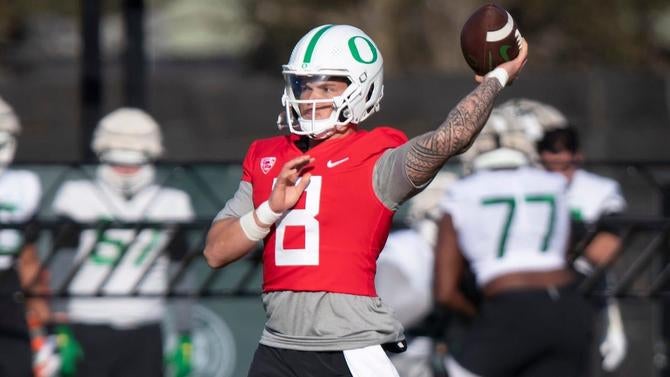
Oregon spring practice ahead of the 2024 season reaches its conclusion with the annual spring game taking center stage on Saturday in Autzen Stadium. The game serves as the final public football event for the Ducks as members of the Pac-12 with an official move to the Big Ten on the horizon in July. So, while there's plenty of conversation and speculation about the depth chart, development of young stars and how the portal additions have acclimated to the team, there's a march larger point of intrigue considering where Oregon sits in the national picture heading into this season.
Is this is a team that can do what hasn't been done in the modern era and win a power conference during its first year in the league?
Recent history would say no.
Since 2010, which we're marking as the starting point for this modern era of conference realignment, the high-water mark for Year 1 in a new power conference is Texas A&M going 6-2 in SEC (2012). Powered by Heisman Trophy winner Johnny Manziel, the Aggies were a force that took the league by surprise immediately and sparked conference-wide adjustments. Despite a head-to-head win over Alabama that season, Texas A&M finished second to the Crimson Tide in the SEC West.
Nebraska went 5-3 in conference play during its first season in the Big Ten (2011), making a statement with wins over Ohio State, Penn State and Michigan State, but the Cornhuskers ultimately finished two games out of first place in the Legends Division.
Louisville compiled a 5-3 conference record in its first year of ACC play (2014), but finished third in the division behind Florida State and Clemson.
Of the 16 examples highlighting a program making its power-conference debut since 2010, none have played for a conference championship and only those three (2012 Texas A&M, 2011 Nebraska and 2014 Louisville) even finished with a winning record in league play.
But what we have with Oregon already feels different because the Ducks aren't moving up in competition as much as they are pushing other Big Ten teams down with their impending arrival. This isn't a program that's agreed to "take the checks and take the losses" with a move up in competition as Oregon views itself in a way that many Big Ten schools don't at this point in time: a program that competes for national championships.
Since the hire of Dan Lanning, Oregon has adopted his top-to-bottom vision of how a national-championship program is built and run in the modern era. The Ducks are recruiting at a high level out of high school while also adding game-changing talent from the transfer portal. They've adapted to the needs and personality of the modern player without sacrificing some of the old-school tenets that prove to be foundational building blocks of championship programs in college football. Lanning demands consistency from his players and staff as well as a relentless pursuit of excellence that has already delivered results on the field.
But it has yet to deliver a championship, or even a College Football Playoff appearance.
There's a hunger around Oregon to take that next step, which is both the smallest (in terms of margins) and toughest (in terms of challenge) step to take in the ascent of a college football program. And one of the biggest storylines for the Big Ten in 2024 is whether Oregon, in its debut as a conference member, will take that step, and in doing so, make modern conference realignment history by playing for a conference title in Year 1.
Winning at the margins
Oregon is 22-5 since Lanning took over, and in two short years, he's already delivered one of the winningest seasons in program history (12 wins in 2023; tied for second behind the 13-2, CFP runner-up finish in 2014) as well as one of the highest-rated recruiting classes in program history (3rd nationally in 2024, according to 247Sports Composite). In February, after finishing off that top-three class, Lanning told Oregon's radio crew this team "is the most talented roster I've had since we've been here." The on-field success of the last two seasons and the on-paper talent advantage Oregon will have against many of its opponents have set the stage for those championship expectations. Championships are not decided on paper, though.
While winning 22 of 27 games across two seasons certainly signifies success, Oregon's shortcomings at the margins have prevented the Ducks from accomplishing all of their goals. Since a 49-3 loss to Georgia in Lanning's debut on Sept. 3, 2022, Oregon has not been defeated by more than four points. The combination of a three-point loss to Washington and a four-point loss to Oregon State in November 2022 kept the Ducks out of the Pac-12 Championship Game, and last season featured not just one but two three-point losses to the rival Huskies.
The first defeat, on the road in Seattle, included failed fourth-down attempts, yielding a 53-yard touchdown drive on two plays and a missed game-tying kick. The second came in the Pac-12 title game where Oregon did not give the game up as much it had to climb out of a two-score, first-quarter hole to get back into the game late. In all four losses, there are a handful of painful moments for Oregon fans to revisit; if just a few different results go their way, the Ducks are right in the middle of the national championship picture. The math doesn't add up exactly, but this is essentially a 22-5 program over the last two years that's just a few plays away from 26-1.
When a roster is as talented as Oregon's, achieving your goals is going to come down to execution and winning at the margins.
"We're not going to be a team that beats ourselves," Lanning said after the team's second scrimmage last weekend. "That's something we have to improve on from last season."
That's where the top-to-bottom vision of a championship program comes into play, where Lanning's experience of seeing how players need to carry themselves to compete at the highest level pays off for the Ducks. Those seemingly small, self-inflicted errors in the biggest games have added up in a way that has left Oregon wanting more and knowing it can achieve more. That's a big focus of how the Ducks are preparing not just for life in the Big Ten, but how a season is going to play out when you start firmly in the position of a national championship contender.

Passing game and pass defense in the spotlight
Don't expect a lot of unique football from a scheme perspective in the Oregon spring game, but there are a couple of spots where we could gain further insight. Some of the most intrigue, on both sides of the ball, will come from Oregon's passing attack in the post-Bo Nix era as well as the pass defense -- with all aspects of that competition featuring notable transfer portal additions.
Oregon was able to land two experienced quarterbacks from the portal, headlined by Dillon Gabriel arriving after an extremely productive year at Oklahoma where he added plenty of yards to his career totals that stretch all the way back to his debut at UCF. With Gabriel expected to serve as the QB1 from the jump, the spring game and the rest of the offseason will also include plenty of excitement around the development of former five-star prospect Dante Moore. Originally committed to Oregon out of high school, Moore flipped to UCLA before signing day and then even earned a couple starts for the Bruins as a true freshman last season. Things did not go well for the rookie, and now he gets a fresh start with what seems to be a nice runway for development. The raw tools are worthy of his five-star projection coming out of high school, and whether it's in 2024 or beyond, the hope is he'll be ready to deliver when his number is called.
In terms of pass catchers, the Ducks took a huge step forward last year with offensive coordinator Will Stein. Oregon had not produced a 1,000-yard receiver since 2018, but two emerged last season: Troy Franklin (1,383) and Tez Johnson (1,182). Johnson is back, as is third-leading receiver Traeshon Holden and fourth-leading receiver Gary Bryant Jr., both of whom joined the Ducks out of the transfer portal prior to last season. Oregon added even more firepower to that group in the transfer portal during this offseason with the signing of former five-star prospect Evan Stewart out of Texas A&M. Watching how Gabriel and Moore both work in Stein's offense with this group of extremely potent pass catchers will be of great interest as we determine the ceiling for an Oregon offense that was one of the best in the country last season.
Just as intriguing to watch will be how Oregon's retooled pass defense looks against this group of explosive wide receivers. The Ducks ranked first in the Pac-12 and 13th nationally in pass efficiency defense last year, but that group is losing some of the best secondary players like Khyree Jackson and Evan Williams. Lanning and the defensive staff have gone to the portal to maintain that level of excellence, bringing in all-conference defensive back Jabbar Muhammed from Washington, all-conference defensive back Kam Alexander from UTSA and Kobe Savage from Kansas State. All three players are expected to compete for starter's snaps this fall, so seeing them tested against one of the best wide receiver rooms in the country will make for an entertaining show on Saturday.
Oregon's Big Ten title pursuit not in a vacuum
While it is easy to focus on Oregon's crazy roster talent and just how close they have been to competing for championships in each of the last two years, its pursuit of a historic Big Ten title is not happening in a vacuum. Oregon may have one of the most talented rosters in program history, but there's a strong argument that the most talented roster in the Big Ten belongs to Ohio State. And while Oregon has been knocking on the door of the College Football Playoff each of the last two years, the Ducks are going to competing in a Big Ten with three programs -- Michigan (twice), Ohio State, Washington -- who have combined for four CFP appearances in the last two years. If Oregon is going to win the Big Ten and become the first team in this modern realignment era to win a conference in Year 1, it will have to topple programs that have accomplished more in the last two seasons.
That's why the last step in the path to championship contention is the hardest, even though it comes with the smallest margins. A program like Oregon can do everything in its power to load up the roster with championship talent and try to instill the habits and routines that produce winning at the highest level. But, to finish on the top of the mountain, you have to knock someone else off, and the re-tooled Big Ten that Oregon is joining has a top tier that is more competitive than any other in the country. Even with a loaded field, though, it's hard not to like the Ducks' chances of making history with a Big Ten title in Year 1.






















